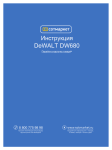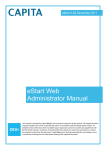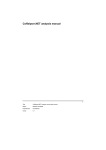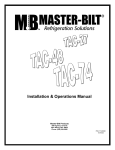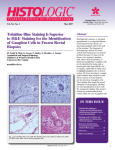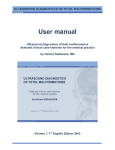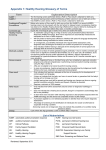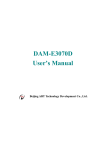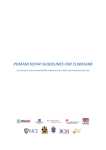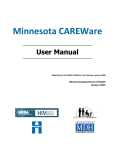Download Birth Defects Follow-up Manual for Local Public Health
Transcript
2014 Birth Defects Program Local Public Health Follow-up Manual Minnesota Department of Health Children & Youth with Special Health Needs Birth Defects Unit June 2014 Protecting, maintaining and improving the health of all Minnesotans Table of Contents Birth Defects Monitoring & Analysis Program (BDMAP) Overview & Background ......................... 3 Statutory Language ................................................................................................................................... 3 Expanded Birth Defects Program Follow up ............................................................................................ 3 Data Collection ......................................................................................................................................... 4 How Does the Birth Defects Program Benefit Minnesota? ...................................................................... 4 The Birth Defects Program’s Partnership with ....................................................................................... 5 Local Public Health (LPH) ......................................................................................................................... 5 MDH Birth Defects Program and EHDI: Growing Together ................................................................... 5 Differences and Similarities of the Programs ........................................................................................... 5 Key Contacts ............................................................................................................................................. 5 Key Contacts Responsibilities .................................................................................................................. 5 Training for Key Contacts ........................................................................................................................ 5 Resources for LPH .................................................................................................................................... 6 Confirmed Birth Defects ............................................................................................................................ 7 Overview ................................................................................................................................................... 7 Parental Opt Out Process .......................................................................................................................... 7 Birth Defects Address Assistance .............................................................................................................. 9 Birth Defects Follow Up ............................................................................................................................. 9 Goal of Follow up ..................................................................................................................................... 9 Strategies of Follow up ........................................................................................................................... 10 Connecting with the family ................................................................................................................. 11 Contacting the family when another Public Health Nurse (PHN) is involved ................................... 12 Confidentiality and HIPAA ................................................................................................................. 12 Documenting Your Follow up in MEDSS............................................................................................... 14 Tracking Cases .......................................................................................................................................... 16 MEDSS Case Status Workflows ............................................................................................................. 16 MEDSS Tracking Reports ...................................................................................................................... 16 Invoicing for Completed Birth Defects ................................................................................................... 17 Follow up and Trainings .......................................................................................................................... 17 LPH Frequently Asked Questions ........................................................................................................... 18 1 Protecting, maintaining and improving the health of all Minnesotans Appendix 1 – Birth Defects Contact Information .................................................................................. 21 Appendix 2 – Timeline of Birth Defects Follow Up by Local Public Health Agencies, 2010-2014 ... 22 Appendix 3 –Conditions included in the Minnesota Birth Defects Information System ................... 23 Appendix 4 – Similarities and Differences with Birth Defects and EHDI Programs ......................... 24 Appendix 5 – Birth Defects Process Flow Chart .................................................................................... 25 Appendix 6 - Letter sent to parents of children with birth defect ........................................................ 26 Appendix 7 – Parent Frequently Asked Questions ................................................................................ 27 Appendix 8 – HIPAA ................................................................................................................................ 28 Appendix 9 - Reimbursement for Birth Defects cases ........................................................................... 30 Appendix 10 – Invoice Form .................................................................................................................... 31 Appendix 11 – Special Health Needs Resources..................................................................................... 33 Resources for Children & Youth with Special Health Needs ................................................................. 33 Glossary ..................................................................................................................................................... 35 2 Protecting, maintaining and improving the health of all Minnesotans Birth Defects Monitoring & Analysis Program (BDMAP) Overview & Background The Birth Defects Monitoring & Analysis Program (BDMAP) at the Minnesota Department of Health (MDH) gathers data about selected birth defects diagnosed in the first year of life. An estimated 2,000 babies are born in Minnesota each year with a birth defect. The mission of the program is to help children thrive, grow, and be as healthy as possible. The primary goals of the Birth Defects Program are to: • • • • • Monitor incidence trends of birth defects to detect emerging health concerns and identify affected populations, Ensure appropriate services are provided to affected families, Prevent birth defects through targeted education, Educate health professionals and the public regarding birth defects, and Stimulate research on risk factors, treatment, prevention, and the cure of birth defects. Statutory Language The 2004 Legislature amended the birth defects statute (MS 144.2215) to enable establishment of the Minnesota Birth Defects Information System (BDIS). This included clarifying language on goals, data sources, reporting without liability, data privacy, an opt–out clause, and guidelines on conducting research. The definition of a “birth defect” is consistent with that used by the Centers for Disease Control and Prevention (CDC), other states, and national organizations. This language became effective March 2005, when the MDH received a federal grant to support implementation of a regional birth defects program. During the 2010 legislative session, financial support was provided to expand birth defects activities statewide. Expanded Birth Defects Program Follow up In its initial years, the Birth Defects program depended on the MDH Children with Special Health Needs program staff to assist families with available services appropriate for their children. After a few years, local public health agencies began to get more directly involved with the Birth Defects program to assist these children. When the program began expanding in 2010, MDH extended its existing partnerships with local public health and tribal agencies for referral to services and programs available in the communities where these families live. By 2013, all 87 counties and one tribe were part of the follow up working to assure services are offered to children with birth defects who are included in the BDIS. A timeline showing the birth defects follow up by local public health agencies is provided in Appendix 2. 3 Data Collection Minnesota began active birth defects surveillance on June 1, 2005. Birth conditions being tracked in 2014 include almost all of the birth defects recommended by the National Birth Defects Prevention Network (NBDPN). Appendix 3 lists the conditions tracked by Minnesota for 2013 births. The birth defects program website includes a link to the most current and comprehensive surveillance data report: http://www.health.state.mn.us/divs/cfh/program/cyshn/cyshndata.cfm#birth A selection of the birth defects monitored is included in the Minnesota Public Health Data Access Portal developed by the Minnesota Environmental Public Health Tracking Program: https://apps.health.state.mn.us/mndata/birth_basic . Their website provides tables and charts, general information about the birth defects data and measures, as well as prevention messages. How Does the Birth Defects Program Benefit Minnesota? There are many programs in our state that may benefit children with birth defects and their families. Knowledge of the occurrence of birth defects will help MDH link families to the services they need. Better tracking of when and where birth defects occur and potential links to risk factors will provide critical information that may help prevent birth defects in the future. Despite the fact that 100,000 to 150,000 babies are born each year in the US with major birth defects, many of the actual causes of birth defects are not completely understood. 4 Protecting, maintaining and improving the health of all Minnesotans The Birth Defects Program’s Partnership with Local Public Health (LPH) MDH Birth Defects Program and EHDI: Growing Together After the Early Hearing Detection & Intervention (EHDI) program’s partnership with local public health and tribal governments was initiated, the Birth Defects program recognized that a similar partnership could be beneficial for children with confirmed birth defects. In 2011, at the time of the contract renewal, LPH agencies and tribal governments were given the option to partner not only with the EHDI program but also the Birth Defects program. Small grants for the purpose of expanding birth defects service delivery coordination throughout Minnesota were offered to help with the expansion of the program. Differences and Similarities of the Programs Although the EHDI and Birth Defects programs at MDH are separate teams, they are working together to make follow up for children with hearing loss and children with birth defects coordinated. Both programs collect data in the same newborn module of the secure Minnesota Electronic Disease Surveillance System (MEDSS) database, the current platform for BDIS. Please refer to Appendix 4 for a summary of the two programs differences and similarities LPH agencies may encounter. Key Contacts MDH has asked each agency to identify at least one person within their agency to be the Birth Defects key contact and at least one person to be an EHDI key contact. This may be the same person for both programs but does not have to be; however, we ask that no more than two key contacts per program be designated per county. Key contacts are expected to coordinate follow up and communicate program changes to other staff working on EHDI and Birth Defects follow up within their county. Each key contact must request access to MEDSS and fill out appropriate forms to obtain access. Details of forms and process are discussed in the EHDI-BD MEDSS Manual. Key Contacts Responsibilities The primary responsibility of key contacts is ensuring that follow up on cases occurs in a timely fashion. Occasionally, MDH will request assistance from key contacts to help find the family’s current address prior to follow up. Key contacts will also obtain and maintain their access to MEDSS. Additional follow up requirements and information are available on page 10. Training for Key Contacts All key contacts are expected to participate in trainings that MDH determines necessary to perform program requirements. The county will be reimbursed for required training up to a maximum of one staff per county per program. If a key contact changes, MDH will reimburse the county for a new key contact to complete the required training. 5 Resources for LPH Many of the materials provided in this Follow up Manual, plus additional resources, are available online. The EHDI and Birth Defects website for LPH and tribal governments is: http://www.health.state.mn.us/divs/cfh/program/cyshn/lph.cfm. Go to this website to access the most up-to-date versions of forms and trainings. Key contacts and others involved in the Birth Defects program also receive a monthly newsletter from the EHDI and Birth Defects programs. This newsletter contains important information about program updates and hearing loss or birth defects resources. Newsletters are sent via email. Please take time to look through the newsletter each month to make sure you have the most upto-date information about the programs. The newsletter is also available online at http://www.health.state.mn.us/divs/cfh/program/cyshn/lph.cfm#newsletters. 6 Protecting, maintaining and improving the health of all Minnesotans Confirmed Birth Defects Overview Hospitals and clinics report to MDH a limited set of information each month about infants discharged from their facilities who were treated for any of the monitored birth defects. Diagnostic codes used for billing (i.e. ICD-9 or ICD-10 codes) are how these children are identified. MDH abstractors then go to the facilities and review the medical records for additional details about the condition. Information from the medical record that supports a diagnosis of a birth defect is entered into the birth defects database in MEDSS. Each potential case is verified by ensuring it meets strict case definitions that are consistent with national standards. If the case definition has been met, the abstractors assign the most appropriate birth defect code based on the confirmatory evidence from the medical records. Finally, an MDH nurse specialist reviews the completed case abstraction to ensure the most accurate and consistent birth defect codes have been assigned. If necessary, MDH staff may consult with medical specialists for further clarification of complex conditions. At this point, a birth defects “case” has been created. This process is depicted in the first four boxes in the flow chart in Appendix 5. Parental Opt Out Process Since its start in 2005, the MDH Birth Defects Program has made extensive efforts to assure that the monitoring process meets both statutory and public health needs. The law that established the BDIS also gave parents the right to have their own and their child’s identifying information removed from the system, called an “opt out”. After abstraction and a nurse case review verifies that a child has been diagnosed with a birth defect, MDH mails a letter to the parents or guardians, providing them information about the birth defects program and basic information about services that may be available to them. A copy of the parent letter is available in Appendix 6. The parent letter mailing also furnishes an opt out form, which parents or guardians must complete and return if they choose to have their identifying information removed from the database. The Birth Defects program waits two weeks to allow parents time to return the opt out form before any information is shared with authorized entities that may help the family obtain services. Local public health agencies are the only authorized groups with which we share identifying information, and that is done only if the parents have not opted out. Parents or guardians can send in the opt out form any time to have their information removed; however, local public health may have already been notified of the family after the two week delay has passed. When an opt out form is received, MDH de-identifies the case in MEDSS and sends a confirmation letter to the family telling them that their identifying data has been removed from the system. Once the opt out has been processed, the case no longer contains names or other 7 personal identifying information in MEDSS. If the local public health agency has already been notified of the child, Birth Defects staff immediately contacts the agency asking them to discontinue trying to reach the family on behalf of the Birth Defects program. As a precaution, agencies are also asked to remove any identifying information connected to that child they might have from the birth defect notification. However, the LPH agency continues to retain information on the child they may have because of prior involvement with other programs. If LPH has completed follow up and documented it in MEDSS prior to the family opting out, they still invoice for the case. Please refer to the right column of the flow chart of this process in Appendix 5. 8 Protecting, maintaining and improving the health of all Minnesotans Birth Defects Address Assistance When a parent letter mailing is returned to MDH as “undeliverable”, MDH staff may ask the LPH key contact from the county in which the family last resided for help finding the family’s current address. Once the parent letter is returned to sender, MDH staff will either send the LPH key contact an email or send a task through MEDSS to ask for assistance. This family has not yet received the parent letter mailing; they do not know that their child has been included in the BDIS nor that they have the right to remove their identifying information (opt out). The request for address assistance is a separate process than follow up, which begins two weeks after the parent letter mailing has been successfully delivered. When the key contact receives the email or task requesting a current address so the parent letter can be re-sent, the key contact will have to check the BD LPH Request Address Check workflow to locate the case. The key contact is temporarily given access to the case in MEDSS while looking for the family’s current address. The key contact documents the results of their search using the New Address Request Wizard. Please refer to the left column of the flow chart of this process in Appendix 5. No information should be entered into the Local Public Health Wizard at this time. After completing the New Address Request Wizard, access to the case is removed. If LPH was unable to find a new address, MDH will mark the case as Lost to Follow Up and LPH will not be notified of the event again. If a new address is located, the MDH parent letter mailing will be resent. After the two week waiting period, the appropriate LPH agency will be notified of the case for follow up. MDH will reimburse the agency $75, even if the address assistance search did not result in a new address. This reimbursement is only for circumstances when MDH specifically requests address assistance to resend the parent letter mailing. The standard updating of addresses that takes place later during follow up to ensure services is included in the tier payment. Refer to BD-HL LPH MEDSS User Manual for more information on using the New Address Request Wizard. Birth Defects Follow Up Goal of Follow up The main goal of your follow up on children with a confirmed birth defect is to ensure that they are connected with all of the appropriate early intervention, financial, health and community services that are available in your area. When there is a case within in your area requiring follow up, you will receive an email from MDH notifying you about it. MDH sends out notifications for follow up about every two weeks. You may not have a new case every time we send out notifications. All cases requiring follow up will be in your BD LPH Documentation Not Completed workflow in MEDSS. Cases for which 9 no reimbursement for follow up is available are found in the BD LPH Low Acuity Cases in Last 90 Days workflow. Please refer to Appendix 5 for a flow chart of this entire process. When MDH sends you a case for follow up, the parent or guardian should already have received the parent letter mailing; the letter lets parents know that your agency may contact them about educational, financial, or support services in the area. For follow up purposes, the MDH nurse specialist assigns an acuity level to each case based on the severity of the child’s birth defect(s). This is intended to help you prioritize follow up. Agencies will be reimbursed for reporting follow up with families whose children have a medium or high acuity condition. While you may follow up on low acuity cases and document them in MEDSS, you will not be reimbursed for it. Within three months of notification for follow up, the key contact (or designee) should try to contact the family to identify needs, document current services being used, and discuss any additional services that may be beneficial and for which the family is eligible. The key contact should ensure referral and connection to appropriate services. These may include, as needed: • • • • • • • primary care (ideally a medical home) specialty care early intervention financial resources transportation parent-to-parent support and other professionals/services All eligible children should be connected to Part C/Early Intervention Services and Supplemental Security Income (SSI). Some of the birth defects monitored make the children categorically eligible. Key contacts are responsible for assigning cases to other staff for follow up, if appropriate. Agencies must report the results of their follow up in MEDSS in order to be reimbursed. As part of follow up, it is expected that all address and contact information will be updated in MEDSS until follow up has been completed and invoiced. Update the contact information in the Address Information tab located within the Persons tab of the child’s record in MEDSS. Instructions are available in the BD-HL MEDSS Manual. This process is different from the address assistance requests, which MDH initiates when the parent letter mailing was returned to sender and are reimbursed separately. Strategies of Follow up LPH agencies provide most of the case management and direct service referrals for birth defects in Minnesota. How you follow up on these cases will depend on the resources and health services available in your community. Therefore, there is no “correct” way to follow up on these cases. We trust that you will use your knowledge and expertise to achieve this goal to the best of your ability. While there is no one way to follow up on birth defects cases, there are some strategies that MDH considers to be “best practice.” While it is not expected that you use all of these strategies for every case, it is expected that you use your best judgment to determine when it is appropriate to use these strategies. 10 There are two different ways you can help facilitate follow up: • By contacting the child’s parents or guardians directly • By contacting the child’s health care providers or service providers You can use one or both of these methods, based on what you deem will be most effective for the particular case you are working on. More information on “best practice” for each of these strategies is listed below. Before contacting the family, be aware that the birth condition(s) listed in the Diagnosis Code and Description fields in the Child’s Diagnosis section of the wizard are the confirmed birth defect(s) that our program tracks. If the child has other health issues or extenuating circumstances known to the birth defects program, they will be listed in the wizard under the MDH Clinical Diagnosis Comments field. Since the birth defects program only tracks selected conditions, other health issues may not necessarily be finalized diagnoses. Please do not rely on the additional information to be as accurate or current; the information is provided so you are aware that the child may have other serious health conditions in addition to the confirmed birth defect(s) listed. Connecting with the family MDH will provide the LPH key contact with contact information from the child’s birth certificate and/or medical record. You can use this information to try to reach the family to determine what kind of support is needed to get the child appropriate services. If the telephone number appears to be correct and functional (e.g. it is not disconnected and is accepting voicemail messages), you should attempt to contact the family at least two times by telephone. If you leave a message for the family, allow about two weeks between calls for the family to respond. You may find that the family does not respond to your voicemail messages or that the contact information received from MDH is no longer correct. Here are some recommended strategies that may be helpful to get in contact with the family: • • • • • • Check other public health databases for updated contact information (e.g. WIC, Child and Teen Checkups, Home Visiting) Call the primary care provider to see if they have updated contact information Send a letter to the family that stresses the importance of early intervention programs and urge them to get in contact with you or their primary care provider If the family is receiving WIC services, try to connect with them at their WIC appointment If the family is receiving home visiting services, ask the home visiting nurse for assistance in talking with the family and arranging follow up If the family is receiving early intervention/Part C, ask the service provider(s) for assistance or information to assist with connection with the family When talking with the family, keep in mind the common barriers families encounter in following up. You may need to assist the family with obtaining transportation to and from appointments or in signing up for available public health insurance programs. You may also need to educate the family on the importance of early intervention. For families who do not speak English, you may 11 need to arrange interpreter services to communicate or assist them in obtaining an interpreter at medical appointments. When you connect with the family, there are a number of things you should ask them about. An important topic to discuss initially is the child’s health care coverage status. Does the child have adequate health insurance? This will help you determine if lack of insurance is preventing access to services. If so, check if the child is eligible for public insurance, and be sure to provide the family with the assistance signing up. If the child is under age three, ask about their enrollment status with Part C/Help Me Grow. If the child has not been connected with Part C/Early Intervention yet, ask them if it would be okay for you to make a referral. For children three or older, make sure that the family has been connected to their school district for Part B services. If they have not, ask them if it would be okay for you to make a referral. Finally, while you are talking with the family, you may want to determine if there are any financial or social service programs that they may be eligible for. This would be a good opportunity to assist them in getting enrolled in these programs. Contacting the family when another Public Health Nurse (PHN) is involved For situations where another PHN from your agency has already made contact with the family, you would not have to contact the family again for follow up if all of the following are true: • The primary PHN spoke to the family within the past three months • PHN was aware of the birth condition listed in MEDSS at the time of the visit/contact • PHN is assured that the family is aware of and/or receiving all appropriate services for the confirmed birth condition • You would not have anything more to offer the family, such as financial assistance/resources or another service. You would be eligible to invoice at a Tier 2 ($200) reimbursement for obtaining the information from another service provider. Do the following to complete the Local Public Health Wizard in MEDSS: • In the “Is this the first time your agency has been notified about this child?” field, select No. • For each service for which the PHN discussed and/or assisted the family, select the “Yes” check boxes and enter the current status. Document any other services the family is currently receiving. • Select Tier 2 for reimbursement. • In the Indicate type of provider(s) contacted… field, select all that apply. Use the “Other” check box and enter the PHN in the Specify text box. • In the LPH Comments field, document that another PHN is involved with the family as well as any other pertinent information, such as the date the PHN spoke to the family, and the PHN was aware of the confirmed birth condition. Confidentiality and HIPAA Some clinics may be hesitant to share information with you due to HIPAA. As a contractor with MDH, you are doing public health surveillance work that is HIPAA-exempt. See Appendix 8 “HIPAA and Medical Information Related to Birth Defects, Diagnosis, and Intervention” for 12 MDH’s legal interpretation of why the work you do relates to birth defects and is HIPAAexempt. You can make a copy of this document and send it to the clinic to show them that they will not be violating HIPAA. This document is also available at http://www.health.state.mn.us/divs/cfh/program/cyshn/lph.cfm#resources. 13 Protecting, maintaining and improving the health of all Minnesotans Documenting Your Follow up in MEDSS When you have completed your follow up with the birth defects cases, you will need to report the outcome of your follow up to MDH using MEDSS. The Birth Defect Local Public Health Wizard is divided into sections. The first three sections are: Child’s Information, Child’s Diagnosis, and Contact Information: Parent/Guardian. These sections display background information you will need for follow up. They include child’s age and birth information, diagnostic information collected from the medical records that were reviewed, acuity and any comments from MDH. Any contact information we have collected on the parent or guardian is also provided to assist with follow up. If you become aware of a change in guardianship, we ask that you provide the name and contact information in the comments box within the wizard and contact a birth defects staff about the changes and updates. A birth defects staff will then enter the changes within MEDSS. To be reimbursed for medium and high acuity-level cases, you will need to complete the following sections within the Birth Defect Local Public Health Wizard: • Health Care Information (optional) o Does the child have a primary care provider o Primary care providers name o Primary care providers clinic o Type of insurance the child currently has • State and Local Services o Is this the first time your agency has been notified about this child? o Medicare/Medical Assistance o TEFRA o MinnesotaCare o WIC o Follow Along Program o Parent to Parent or Family Support Organizations o Did you discuss any other programs/services (optional) • Federal Programs: Early Intervention/Part C, SSI o Early Intervention/Part C o SSI • LPH Follow up Information o What tier you would like to be reimbursed for (depending on the choice other options will “drop down” which must be filled out such as: checked all available databases/sources of information, spoke with the parent, etc.) o Other database sources/information checked o LPH comments (optional) o LPH: check this box when documentation is ready for MDH review 14 During the course of your follow up you may find that the family has relocated to a different county. Document the new address in LPH comments text box. Use your professional judgment to determine if the family would benefit from connection to services in the new county. If the family would benefit from services, refer to the new county. MDH will not automatically refer a case to a second county if the first county has provided complete documentation. The second county would not be eligible for reimbursement from MDH. If you are not able to provide documentation that qualifies for reimbursement, MDH will refer the case to the second county/agency. If you receive additional information on a case for which you have already invoiced and been reimbursed, you are not required to notify MDH or update the MEDSS event. Additional instructions and screen shots of required documentation is available in the BD-HL MEDSS User Manual. 15 Protecting, maintaining and improving the health of all Minnesotans Tracking Cases Timely completion of follow up for birth defects notifications is important in ensuring that children with birth defects are receiving the services they need. LPH agencies, especially agencies that receive a high volume of notifications, need to create an effective tracking system to ensure all cases sent by MDH are being followed up upon in a timely manner. MEDSS Case Status Workflows The MEDSS case status workflows provide an easy way for you to view the status of cases that require some further action before they are fully complete. The five birth defects workflows are: • BD LPH Documentation Not Completed – contains cases where LPH documentation has not yet been completed. This list is limited to those cases for which you may be reimbursed. • BD LPH Cases Waiting for MDH Review – contains cases where LPH has indicated that they have completed their documentation, but MDH has not yet reviewed the case to see if it is ready to be invoiced • BD LPH Cases Ready to be Invoiced – contains cases for which MDH has reviewed documentation provided by LPH and approved them for invoicing. • BD LPH Low Acuity Cases in Last 90 Days - contains all low acuity cases assigned to your county with in the last 90 days. There is no reimbursement for completing follow up for these cases. • BD LPH Request Address Check - contains cases for which MDH has requested your assistance in locating a more recent address for a family so MDH can resend the parent letter packet. For detailed information on how to access the case status workflows in MEDSS refer to the BD-HL MEDSS User Manual. MEDSS Tracking Reports The MEDSS tracking reports are available to you in MEDSS as another way to help you to track the cases that have been sent to you. There are two different ways you can track cases: by sent date or by completed date. Sent date is the date you were notified of the case by MDH. • Completed date is the date MDH reviewed a case you indicated was complete and determined that all necessary follow up had been completed. Detailed instructions on how to create these reports in MEDSS can be found in the BD-HL MEDSS User Manual. 16 Protecting, maintaining and improving the health of all Minnesotans Invoicing for Completed Birth Defects Follow up and Trainings Invoicing for the Birth Defects program is done on a quarterly basis and is done in conjunction with the EHDI program. You only need to fill out one invoicing form for work completed for EHDI and Birth Defects, and for any trainings completed within the invoicing period. The quarterly invoicing schedule is listed below: Invoicing Period January 1st – March 31st April 1st – June 30th July 1st – September 30th October 1st – December 31st Invoice Due Date April 30th July 30th October 30th January 30th You must bill for all work completed during an invoicing period by the invoicing due date. You do not need to submit an invoicing form if you did not complete any EHDI or Birth Defects notifications or trainings during an invoicing period. For birth defects cases, the contract states follow up must be completed within 3 months of notification and invoiced by the next due date. Older birth defects cases that have not been completed or invoiced in a timely manner will be closed out every quarter, according to this schedule. Late cases will not be reimbursed; however, you may continue to work with the family in your regular role at your agency. Instructions for completing the EHDI and Birth Defects invoice and the most recent version of the invoicing form can be found in the forms section of MDH’s website for Local Public Health located at: http://www.health.state.mn.us/divs/cfh/program/cyshn/content/document/pdf/invoice.pdf. Information on reimbursement rates can be found in Appendix 9 and an example of the form is available to see in Appendix 10. 17 Protecting, maintaining and improving the health of all Minnesotans LPH Frequently Asked Questions 1. Why can’t I save changes I made in MEDSS? “The circle keeps spinning” The issue you are having with the circle continuously spinning may be a compatibility issue between your computer's browser and the MEDSS system. When this happens, we suggest checking with your agencies informatics technicians to see if changing the browser is an option. Fire Fox seems to be the most compatible with MEDSS. Sometimes it has something to do with "Java." If you continue to have issues, please let us know and our MEDSS informatics technicians will connect with your informatics technician to resolve the issue. 2. Why can I only see the old tier level option to select for reimbursement? Due to a glitch in MEDSS, the new 2014 tier levels are not always showing up in all events/cases. You should contact MDH Birth Defects staff, Barbara Kough, so she can adjust it so that the correct tier level choices are available. 3. Will MDH ever want to see the birth defects key contact’s phone notes or written documentation of services provided or contact made with families? As long as you document your activities, contacts and follow up to families in MEDSS using the Local Public Health Wizard, you will satisfy our statutory requirement to assure connection of appropriate services for kids with birth defects (M.S. 144.2215 Subd. 2.2) and meet our criteria for reimbursement. There is no need for you to retain those records from our perspective. This speaks only to MDH’s requirement and does not address any potential need for retaining them from your agency’s perspective. This is a decision that should be made locally by each individual agency. 4. Does MDH have a letter template that LPH can use when sending letter to families? MDH does not have a template for a follow up letter to families, as each county may offer different programs, staffing, etc. MDH has decided to leave the letter format and content up to individual local public health agencies to develop and use as they see appropriate. 5. During the course of my follow up I learned the child is deceased. Do I continue documenting my follow up in MEDSS? Will I be reimbursed? You will still be reimbursed. If you learned of the death through your initial research and did not speak with the family or a provider, use Tier One at $75 reimbursement. MDH will waive the letter/call attempts requirements if the child has passed away, but you still have to select those check boxes to complete the case. Just put documentation in your notes/comments. If you learned of the death from a provider, you can bill for Tier Two and would still need to complete the service status fields. If you learned of the death from the parents, it would be $400 reimbursement. You still need to complete the required 18 fields; use your best judgment to assess whether the parent would be willing to discuss the services they were receiving for their child. Please put any information about the child’s death (e.g. cause, where it occurred such as which hospital, at home, etc.) and approximate date of death in the comments field. 6. Should I automatically refer a child to Help Me Grow without parent’s knowledge? Yes, Help Me Grow is a program that can assist with referrals to other programs and resources to prevent developmental delays, even if the child doesn’t qualify for Part C/Early Intervention. Any Minnesota child that has a diagnosed physical or mental condition with a high probability of resulting in a delay, regardless of whether it has been demonstrated, may qualify. Some of the conditions include hearing/vision loss, prematurity (<3lb. 5 oz.), cerebral palsy, Down Syndrome, and some metabolic/endocrine disorders. See http://www.health.state.mn.us/divs/cfh/program/cyshn/delay.cfm#table for a list of conditions. 7. Why is my county receiving referrals for children who are two or three years old? In the first years of sending notifications to LPH, MDH sent all cases regardless of age to LPH. MDH left it up to each LPH agency to determine if it was appropriate to follow up with the family of an older child, given the agency’s available resources. Based on LPH feedback, MDH is trying to increase the timeliness of notifications. Notifications for older children will continue to decline as we improve our case finding and validation processes. There will always be one or two cases that were reported to MDH late or which were diagnosed when the child was older, so key contacts will still occasionally receive a notification of a child who has recently turned two. Remember, each county has the discretion to decide not to follow up with older children. Please let us know if you receive older cases more frequently than you feel is reasonable. 8. What should I do when my county is referred a case that should go to a different county? MEDSS system selects a county based on the zip code listed in the hospital record. If you receive a case that should go to a different county, you should contact MDH Birth Defects staff, Barbara Kough, so she can remove jurisdiction from your county and refer to the correct county. 9. What tier can I bill for when I reach a member of the extended family, but am unable to reach the parent/guardian or service provider? When we use the term “family,” we mean the parent or legal guardian. It was never the intention of the Birth Defects program to have key contacts discussing services and programs with members of the extended family. We only feel comfortable discussing the private information related to the child’s medical condition with the person who has the authority to make decisions regarding the child’s health and program enrollment. This is in line with how EHDI reimburses cases as well. If you speak to the parent or legal guardian, you can bill for Tier 3/$400 once you have documented your follow up. If you speak to a service provider or another health provider, you may bill for Tier 2/$200. If you are only able to reach a member of the extended family, you can bill for Tier 1/$75 for the attempts to reach the parent or guardian. 19 10. What response option should I chose if the family has moved out of my contact service area? The response option “child moved out of county” should be selected in the “If LPH unable to connect with family, reason:” field whenever the family has moved out of the key contact’s service area. This response is appropriate whether they have moved out of the county, state, or even the country. Any specifics about where the child moved are most helpful to have in the LPH comments field. (The “Other” response should be used rarely when none of the other responses apply at all. It is hard for us to utilize this information and it often gets missed when the case is reviewed by MDH.) 11. I thought that LPH has no contractual obligation to follow up on all cases sent to the agency? Each agency can determine which cases they will prioritize for follow up. Some counties follow up on all cases, even those with milder conditions (low acuity) for which they are not reimbursed. Other counties request “no reimbursement” for some of the medium or high acuity cases. The contract states that the county will ensure referral and connection to appropriate services. If the key contact feels this has been done with the family and no further follow up is necessary, then the “no reimbursement” may be requested for a case. The case will then go off your workflow and be closed. 20 Protecting, maintaining and improving the health of all Minnesotans Appendix 1 – Birth Defects Contact Information Barbara Kough Operations Coordinator [email protected] (651) 201-5631 MEDSS Help Email [email protected] Birth Defects General Email Address [email protected] Karen Peterson Nurse Specialist [email protected] (651) 201-3585 Important MDH Websites EHDI and Birth Defects website for Local Public Health Contains forms, training materials, tools and resources for LPH http://www.health.state.mn.us/divs/cfh/program/cyshn/lph.cfm Birth Defects Monitoring and Analysis Program http://www.health.state.mn.us/divs/cfh/program/cyshn/bdmaintro.cfm Children and Youth with Special Health Needs http://www.health.state.mn.us/divs/cfh/program/cyshn/ MEDSS login https://apps.health.state.mn.us/medss/login.do Find a local Health Department or Community Health Board http://www.health.state.mn.us/divs/opi/gov/find/ 21 Appendix 2 – Timeline of Birth Defects Follow Up by Local Public Health Agencies, 2010-2014 22 Appendix 3 –Conditions included in the Minnesota Birth Defects Information System (2013 births) The Minnesota Department of Health (MDH) tracks 46 different birth conditions in Minnesota children. Many of these conditions are very severe. Other conditions are not life threatening and may be repaired shortly after birth or resolve on their own. These conditions might not be commonly referred to as “birth defects”. Cardiac Conditions *Heart Conditions • Aortic Valve Stenosis • Atrial Septal Defect (ASD) (PFO) • Coarctation of the Aorta • Common Truncus • Ebstein's Anomaly • Endocardial Cushion Defect (AV Canal) • Hypoplastic Left Heart Syndrome • Patent Ductus Arteriosus (PDA) • Pulmonary Valve Atresia and Stenosis • Single Ventricle • Tetralogy of Fallot • Transposition of the Great Arteries • Tricuspid Valve Atresia and Stenosis • Ventricular Septal Defect (VSD) • Total anomalous pulmonary venous return (TAPVR) Central Nervous System Conditions *Brain/Spine Conditions • Anencephalus • Encephalocele • Hydrocephalus • Microcephalus • Spina Bifida Gastrointestinal Conditions *Stomach/Esophagus/Intestinal/Liver Conditions • Biliary Atresia • Esophageal Atresia • Hirschsprung's Disease • Pyloric Stenosis • Rectal and Large Intestinal Atresia / Stenosis Genitourinary Conditions *Genital/Urinary/Kidney Conditions • Bladder Exstrophy • Hypospadias • Obstructive Genitourinary Defect • Renal Agenesis / Hypoplasia Muscular Skeletal Conditions *Muscle/Bone Conditions • Congenital Hip Dislocation • Diaphragmatic Hernia • Gastroschisis • Omphalocele • Reduction Deformity: Lower Limbs • Reduction Deformity: Upper Limbs Chromosome Conditions • Down Syndrome • Trisomy 13 • Trisomy 18 Oral Conditions *Nose/Mouth Conditions • Choanal Atresia • Cleft Lip and Palate • Cleft Palate without Cleft Lip Ear Conditions • Anotia / Microtia Other Health Conditions • Fetal Alcohol Syndrome (FAS) Eye Conditions • Aniridia • Anophthalmia and Microphthalmia • Congenital Cataract Last updated 8/2013 Appendix 4 – Similarities and Differences with Birth Defects and EHDI Programs Program Details Birth Defects EHDI Number of conditions Type of cases 46 reportable birth defects Notification for Birth Defects f/u New address requests (if needed for resending parent letter) BD cases: 1600 notifications/year Address requests: Varies Low acuity: follow up not required or reimbursed Yes Yes 1 (hearing loss only) Hearing screening f/u CHL f/u Communication Methods Birth Defects EHDI Notification method 2x/month cases added to documentation not complete workflow, mass email sent to all key contacts to remind to look at workflow Hearing Screening f/u: follow up form faxed (emailed?) to key contact Volume of cases Follow up on all cases is required LPH HIPAA exemption Goal of LPH notification is to assure family connection to appropriate services Hearing Screening f/u: ~350/year CHL f/u: ~ 200/year Yes Yes Yes Tracking reports sent No. Use MEDSS Workflows. Invoicing reports sent No. Use MEDSS Workflows. Invoicing frequency Parent Letter/Opt-Out High volume agencies can invoice monthly; at least quarterly Yes CHL f/u: individual email sent to key contact notifying them of new case has been assigned to them Yes (monthly for hearing screening follow up) Yes (quarterly for hearing screening follow up) High volume agencies can invoice monthly; at least quarterly No MEDSS Birth Defects EHDI Data Entry Wizards: Local Public Health New Address Request Yes For New Address Requests used to resend parent letter, use separate Workflow and Wizard If new address identified during normal LPH follow up, update address on Persons tab. Yes Wizard: Local Public Health Yes Yes Yes Yes Yes Yes Yes No Yes No Tasking Updating Addresses Acuity assigned to case Workflows Cases ready to invoice Cases waiting for MDH Review Documentation Not Completed Low Acuity Cases in Last 90 Days Request Address Check 24 No Updating addresses is part of the normal follow up for hearing loss cases. Update address on Persons tab. No Appendix 5 – Birth Defects Process Flow Chart Note: All steps are completed by MDH Birth Defects program staff except the blue boxes where “LPH Key Contacts” are indicated. Receive case reports from facilities (Abstractor) Review medical records & abstract (Abstractor) Request address assistance from LPH (Admin. Staff) Search for new address and report results to MDH (LPH Key Contacts) No new address found: Mark “Lost to Follow Up” (Admin. Staff) Review abstract & code (Abstractors) Receive abstracts from Mayo (Epidemiologists) Review abstract and verify coding (Surveillance nurse) If clarification is needed, flag for MD Review (Surveillance nurse) Send parent letters (Admin. Staff) Letter is returned to sender Parent returns opt out form 14 14 day day delay delay Process opt-out form and de-identify case (Ops. Cdtr.) If LPH has been notified, email LPH key contact to stop follow up (Ops. Cdtr.) New address found: Re-send parent letter (Admin. Staff) Notify LPH (Ops. Cdtr.) Attempt to call family and report follow up to MDH (LPH Key Contacts) Review and approve follow up (Services/follow-up nurse) Send invoice to MDH (LPH Key Contacts) Process invoice to pay LPH (Ops. Cdtr.) Last updated 8/2013 Receive Case Reports from Vital Records (Epidemiologists) Appendix 6 - Letter sent to parents of children with birth defect DATE ADDRESS CITY, MN ZIP Dear Parent(s) of CHILD’S NAME: Public health’s goal is to help all children thrive, grow, and be as healthy as possible. To do this, the Minnesota Department of Health (MDH) collects information about certain health conditions that are present from birth. MDH works closely with hospitals and clinics to find children with these health conditions. Collecting this information helps to look for causes and may help prevent them in the future. Some of these health conditions are very serious but many are not. The MDH recently learned your child has, or had one of these conditions. You may be surprised to be hearing from us, especially if your child’s condition is minor. Your local health department may contact you about educational, financial, or support services in your area. You may also call MDH toll-free at 1 800 728-5420 to speak to a nurse about your child and available resources. Once you know what is available, you decide which services may be helpful for your child and family. The law allows MDH to collect information about these health conditions and strictly protects the information that is collected. The law also allows you to remove your child’s name and other identifying information from the birth defects database. If you choose to remove this information, you must sign the enclosed “Opt Out” form and return it to MDH. If you have questions or concerns about the database or want more information before deciding to remove your baby’s name, please contact us by email at [email protected]. If you do remove your child’s name, please realize that in the future MDH and your local public health department will not be able to contact you with information about services or about the prevention, treatment, or cause of your child’s condition. Sincerely, Barbara Kough, Operations Coordinator Birth Defects Monitoring & Analysis Unit P.O. Box 64882 St. Paul, Minnesota 55164-0882 26 Appendix 7 – Parent Frequently Asked Questions My child doesn’t have a birth defect; why did you send this letter? Our program tracks a wide range of birth conditions. A complete list is on the back of this page. Some of the conditions we track are very minor and may have already been corrected or healed naturally. Examples of these conditions are pyloric stenosis (a narrowing of the stomach valve causing eating problems), ASD, VSD, PDA, and PFO (a small hole in the heart causing a heart murmur), or hypospadias (a boy’s urinary problem). Your doctor might not refer to these conditions using the term “birth defect.” We send letters to let you know about our program and to let you know you can choose to have your identifying information removed from our system. Is this a new condition? Do you know something that my child’s doctor doesn’t know? Our letter is worrisome to some parents because it may come as a surprise. Our information about your child comes from hospitals and clinics. Minnesota State Law allows us to receive this information. Please be assured that our program does not have or know any more information about your child than your medical providers. Also, our program is separate from the heel stick and hearing screening your baby had in the newborn nursery. Those programs at MDH would have been in touch with your baby’s doctor directly and quickly if something needed to be rechecked. Why are we getting this letter so long after our child’s birth? We work closely with hospitals and clinics to receive data about children born with one of the conditions we track. Sometimes the hospital report is not reported to us until several months after a diagnosis is made. Therefore you might not receive your letter until much later. We send the letters out as soon as we can so you can choose to have your personal information removed if you wish. What are we supposed to do with the form we received with the letter? You are not required to send the form to us. Only send it to us if you want to remove all your identifying information from our database. We would remove your child’s name, your name, and your address and phone number. The information is always kept secure and only a minimum number of program staff can access it, so if you don’t mind us keeping the information no response is necessary. Appendix 8 – HIPAA HIPAA and Medical Information Related to the Birth Defects Information System Disclaimer of Legal Advice: The following is Minnesota Department of Health (MDH) analysis of how Minnesota Statutes sections 144.2215 to 144.2219 interact with the Health Insurance Portability and Accountability Act (HIPAA) Privacy Rule, 45 CFR parts 160 and 164. This is not legal advice and you should not rely on it as legal advice. Consult with a lawyer for legal advice. Does the Health Insurance Portability and Accountability Act (HIPAA) permit disclosure of specific patient medical information related to birth defects to MDH and contractors working on behalf of MDH (including local public health agencies) without patient authorization? Answer: The Minnesota Department of Health has concluded that HIPAA permits a provider and/or the provider’s medical records department or staff to disclose a patient’s medical information pertaining to birth defects in accordance with Minnesota Statutes sections 144.2215 to 144.2219 without the patient’s authorization. This conclusion is based on review of the HIPAA Privacy Rule available on the website of the U.S. Department of Health and Human Services (DHHS) http://www.hhs.gov/ocr/privacy/hipaa/administrative/privacyrule/index.html). The medical information being disclosed must be related to the birth defect diagnosis, management, and related interventions. This may include, but is not limited to, personally identifiable information on the patient, information on tests and procedures conducted, results of tests and procedures conducted, diagnoses, referrals to other providers and services, and other pertinent information. Rationale: HIPAA governs the use and disclosure of protected health information (PHI). It applies to health plans, health care clearinghouses, and health care providers who transmit certain health claims information electronically. These entities are covered entities under the rule. A covered entity must obtain a written authorization from the individual for the use and disclosure of PHI unless the disclosure is to the individual for treatment, payment, or health care operations or the disclosure falls under one of the specified exceptions. The HIPAA Privacy Rule, specifically 45 CFR §164.512, addresses the uses and disclosures of PHI for which an authorization or an opportunity to agree or object is not required. Section 164.512(b) permits a covered entity to disclose PHI to: “(i) A public health authority that is authorized by law to collect or receive such information for the purpose of preventing or controlling disease, injury, or disability, including but not limited to, the reporting of disease, injury, vital events such as birth or death, and the conduct of public health surveillance, public health investigations, and public health interventions; . . .” Under the HIPAA Privacy Rule, 45 CFR 164.501, public health authority is defined as “an agency or authority of … a State . . . that is responsible for public health matters as part of its official mandate.” Therefore, to the extent that a public health authority is authorized by law to collect or receive information for public health purposes, covered entities may disclose PHI to the public health authority without the patient’s authorization. Minnesota Statutes section 144.2215 requires the Commissioner of Health to establish and maintain an information system containing data on the cause, treatment, prevention, and cure of major birth defects. The Commissioner must design the Birth Defects Information System to allow the Commissioner to monitor incidence trends of birth defects to detect potential public health problems, predict risks, and assist in responding to birth defects clusters; more accurately target intervention, prevention, and services for communities, patients, and their families; inform health professionals and citizens of the prevalence of and risks for birth defects; and conduct scientific investigation and surveys of the causes, mortality, methods of treatment, prevention, and cure for birth defects. Minnesota Statutes section 144.2217 classifies information on individuals collected for the Birth Defects Information System as private data on individuals. The data may only be used for the purposes in Minnesota Statutes sections 144.2215 to 144.2219. Summary In summary, Minnesota Statutes sections 144.2215 to 144.2219 authorize MDH and local public health authorities to collect health information pertinent to the diagnosis, cause, treatment, prevention, and cure of birth defects. Therefore, providers, their medical records departments, and their staff can share medical information with MDH and contractors working on behalf of MDH (including local public health agencies) pertaining to birth defects diagnosis, management, and related interventions without patient authorization. For questions about this analysis, contact: Dave Orren MDH Chief Legal Counsel (651) 201-5742 Minnesota Department of Health March 24, 2014 Forms available at http://www.health.state.mn.us/divs/cfh/program/cyshn/content/document/pdf/hipaabdis.pdf Appendix 9 - Reimbursement for Birth Defects cases Birth Defects Address Assistance: payment of $75.00 per case for researching current address, when MDH requests assistance, for families whose parent packet was returned to sender because their contact information in MEDSS is not current. This is separate from follow up. There are three tiers of reimbursement based on follow up provided and services reported. Tier status is determined by key contact based on criteria described below: Birth Defects Tier One: payment of $75.00 per case for: • Attempting to obtain required information on services used from the child’s Part C/Early Intervention Service Coordinator, other service provider and/or the child’s family but not being able to successfully obtain this information. The process must be documented in the LPH Wizard in MEDSS. Attempts at contact must include at least two attempts by phone and a letter sent to the family to assess current services used and to offer assistance in connecting to other services as appropriate. Birth Defects Tier Two: payment of $200 per case for: • Attempting to contact the family and complete documentation of current services in the LPH Wizard in MEDSS by reviewing data sources and contacting service providers to obtain required information on connection to services. Attempts to contact the family must include at least two attempts by phone and a letter sent to the family to assess current services used and offer assistance in connecting to other services as appropriate. Birth Defects Tier Three: payment of $400 per case for: • Successful contact with the family by phone or in person, and complete documentation of current services in the LPH Wizard in MEDSS. The nurse will ensure referral, application and/or connection to other services as needed. When documenting in MEDSS whether you “discussed” and/or “assisted” the family with services or information, you should only check these boxes when you are asking for $400.00 reimbursement, or if you are requesting $200.00 reimbursement for reporting follow up recently completed by another PHN in your agency that was prior to notification from LPH (see section Contacting the family when another PHN is involved in this manual). These fields require communication with the parent or legal guardian. The only communication that meets criteria for this reimbursement must include correspondence that has an immediate response such as a phone conversation. A letter does not meet the requirements. • Select “discussed this service with parent” check box if you informed the parent about a program or explained the purpose of the program but did not provide a phone number or assistance. • Select “assisted with application or enrollment” checkbox if you provided a phone number, assisted with completing worksheets or paperwork, or provided contact information. If you did not talk with the parents, you can only complete the “current status field” and should leave the discuss/assist fields blank. Instructions and screen shots of required documentation is available in the BD-HL MEDSS User Manual. Appendix 10 – Invoice Form EHDI & Birth Defects (BD) Local Public Health Follow-up CHB/County /Tribal Gov’t Name: Invoicing Period: to Person Completing the Form: Date: Phone Number: Email: Number of PHN’s TRAININGS Required MDH training(s) completed Number of Notifications NOTIFICATIONS EHDI Hearing Screening Follow Up Forms - Federal CFDA 93.283 EHDI Tier 1 – Confirmed Hearing Loss (CHL) Notifications (MEDSS LPH Wizard) - Federal CFDA 93.251 EHDI Tier 2 - Confirmed Hearing Loss (CHL) Notifications (MEDSS LPH Wizard) - Federal CFDA 93.251 EHDI Tier 3 - Confirmed Hearing Loss (CHL) Notifications (MEDSS LPH Wizard) - Federal CFDA 93.251 Birth Defects address update in MEDSS - State Funds BD Tier 1 – Birth Defect notifications (MEDSS LPH Wizard) - State Funds BD Tier 2 – Birth Defect notifications (MEDSS LPH Wizard) - State Funds BD Tier 3 – Birth Defect notifications (MEDSS LPH Wizard) - State Funds **PLEASE SPECIFY TRAININGS/NOTIFICATIONS BEING INVOICED ON PAGE 2** Allowable Amount Amount billed $150.00 $ 0.00 Allowable Amount Amount billed $ 75.00 $ 0.00 $ 75.00 $ 0.00 $ 200.00 $ 0.00 $ 400.00 $ 0.00 $ 75.00 $ 0.00 $ 75.00 $ 0.00 $ 200.00 $ 0.00 $ 400.00 $ 0.00 TOTAL $ 0.00 ORIGINAL CERTIFICATION SIGNATURE I certify that, to the best of my knowledge and belief, the data reported on this document is correct and all transactions that support this report were made in accordance with applicable Federal and State statutes and rules. Authorized Official Signature Date Submission Options: Email scanned signed copy to [email protected] (make sure names of children are not included on invoice) OR Fax signed copy to (651) 201-3655 AND send email to [email protected] to confirm fax Person Who Attended Training Date of Training Name of Training Hearing Screening Follow Up Forms Invoiced Above Please provide LPH ID – do not use child’s name if invoice will be emailed For CONFIRMED HEARING LOSS cases invoiced on page 1, please provide the MEDSS Event IDs in the tables below OR attach list of event IDs printed from MEDSS. EHDI Tier 1 CHL Notifications (MEDSS LPH Wizard) Invoiced Above EHDI Tier 2 CHL Notifications (MEDSS LPH Wizard) Invoiced Above EHDI Tier 3 CHL Notifications (MEDSS LPH Wizard) Invoiced Above For BIRTH DEFECT cases invoiced on page 1, please provide the MEDSS Event IDs in the tables below OR attach list of event IDs printed from MEDSS. Birth Defect Address Updates (MEDSS LPH Wizard) Invoiced Above BD Tier 1 Birth Defect Notifications (MEDSS LPH Wizard) Invoiced Above BD Tier 2 Birth Defect Notifications (MEDSS LPH Wizard) Invoiced Above BD Tier 3 Birth Defect Notifications (MEDSS LPH Wizard) Invoiced Above Page 1 of 2 Appendix 11 – Special Health Needs Resources Resources for Children & Youth with Special Health Needs Family Voices of Minnesota is a grass roots family organization that aims to achieve familycentered care for all children, youth and young adults with special health care needs. Through state and national networks of families and providers, Family Voices of Minnesota provides tools that build partnerships among professionals, patients, and families, and serves as a trusted resource for information to improve health system policies. Lasting Imprint is a non-profit corporation established by individuals committed to fighting congenital heart defects (CHD). Lasting Imprint exists to create a supportive community that will inspire people to join in the fight against congenital heart defects through education, research, and assistance to heart families. Minnesota Hands & Voices provides information, support, and referral to families learning of their child's hearing loss. Parent Guides discuss your concerns with you and will send you information related to hearing loss and other topics of interest. They will also refer you to organizations and information sources, including other families of children with hearing loss, which you may find helpful. Minnesota Organization on Fetal Alcohol Syndrome (MOFAS) is the statewide organization serving as the leading voice and resource on Fetal Alcohol Spectrum Disorders (FASD) in Minnesota. MOFAS provides education and training so FASD is better understood and works to ensure that all women know there is no safe level of alcohol use during pregnancy. PACER Center is a parent training and information center for families of children and youth with all disabilities from birth through 21 years old. At PACER Center, parents will find publications, workshops, and other resources to help make decisions about education, vocational training, employment, and other services for their children with disabilities. Resource Sheet - PDF is a resource sheet available online at MDH Children and Youth with Special Health Needs (CYSHN). 33 Additional Web Resources • MDH General Resource List • MDH Information and Resources for Families • MDH Newborn Disease Specific Fact Sheets • MDH - Diseases and Conditions Identified in Children • Best Practices and Medical Specialists in Minnesota • Additional Links and Resources from Family Voices of Minnesota • Links to Helpful Information from Family Voices of Minnesota • New family income guidelines have been published for disabled children’s eligibility for SSI in 2014. The income guidelines are located at the official social security website • Information on National Certification of Healthcare Interpreters 34 Glossary Abstraction – The process of recording information, identified when reviewing documentation in a medical record or other information source, and entering the information into data fields in a specified format. Information may be recorded on hard copy forms or through formatted data entry computer screens. Birth Defect – An abnormality present at birth. Also called a congenital defect, it can be caused by a genetic mutation, an unfavorable environment during pregnancy, or a combination of both. The effect of a birth defect can be mild, severe, or incompatible with life. Congenital - means existing at birth. Congenital disorder - A disorder that is present at birth. The causes of a congenital disorder include infection, injury, genetics, environmental factors, and others. Event - Event is the term used to describe where information about a person’s disease or condition is stored in MEDSS. One person may have multiple events in MEDSS if they have several different conditions tracked by MDH (for example, a child could have both a hearing loss and birth defect event). Each event will be tied to the person’s core person information (name, birth date, address) but is stored separate from other events in MEDSS. Each event can only be viewed by users who have permission to view that type of condition in MEDSS. Event ID – this is the number associated with a confirmed birth defect case in MEDSS. When LPH is notified of a new birth defect, the email will contain this number. LPH should also use this number to invoice for completed cases. Help Me Grow - The Early Intervention program in Minnesota. Medical Home - A team-based health care delivery model that provides comprehensive and continuous medical care to patients with the goal of obtaining maximized health outcomes. Monitoring - performance and analysis of routine measurements using statistical methods aimed at detecting changes in the environment or health status of populations MEDSS (Minnesota Electronic Data Surveillance System) – This is the online database that MDH uses to store information about confirmed birth defect cases in Minnesota. LPH will report information about their follow up on confirmed birth defect cases in MEDSS. MEDSS login page: https://apps.health.state.mn.us/medss/login.do Registry - A system of ongoing registrations, such that cases of a disease or other health-relevant condition are defined in a population and can be related to a population base. Birth and death registration systems are examples. 35 Surveillance – ongoing, systematic collection, analysis, interpretation, and dissemination of health data on an ongoing bases. Surveillance is conducted to identify potential public health threats or patterns of disease occurrence and risk in a community. See also: Minnesota Public Health Data Access Glossary of Terms https://apps.health.state.mn.us/mndata/glossary 36






































